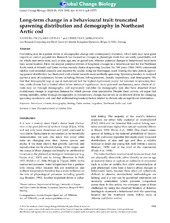Long-term change in a behavioural trait: truncated spawning distribution and demography in Northeast Arctic cod
Peer reviewed, Journal article
Published version

Åpne
Permanent lenke
http://hdl.handle.net/1956/11395Utgivelsesdato
2015-04Metadata
Vis full innførselSamlinger
Originalversjon
https://doi.org/10.1111/gcb.12773Sammendrag
Harvesting may be a potent driver of demographic change and contemporary evolution, which both may have great impacts on animal populations. Research has focused on changes in phenotypic traits that are easily quantifiable and for which time series exist, such as size, age, sex, or gonad size, whereas potential changes in behavioural traits have been under-studied. Here, we analyse potential drivers of long-term changes in a behavioural trait for the Northeast Arctic stock of Atlantic cod Gadus morhua, namely choice of spawning location. For 104 years (1866–1969), commercial catches were recorded annually and reported by county along the Norwegian coast. During this time period, spawning ground distribution has fluctuated with a trend towards more northerly spawning. Spawning location is analysed against a suite of explanatory factors including climate, fishing pressure, density dependence, and demography. We find that demography (age or age at maturation) had the highest explanatory power for variation in spawning location, while climate had a limited effect below statistical significance. As to potential mechanisms, some effects of climate may act through demography, and explanatory variables for demography may also have absorbed direct evolutionary change in migration distance for which proxies were unavailable. Despite these caveats, we argue that fishing mortality, either through demographic or evolutionary change, has served as an effective driver for changing spawning locations in cod, and that additional explanatory factors related to climate add no significant information.
